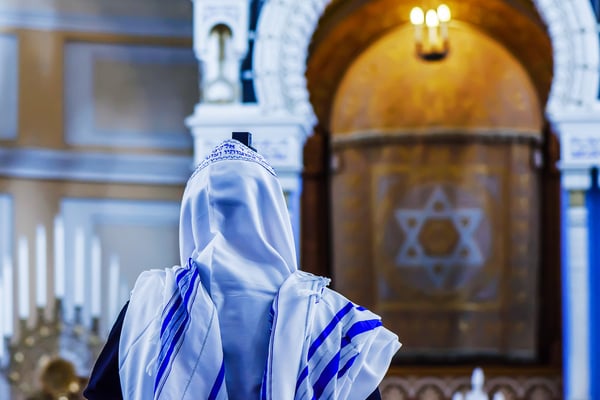The commandment to build the tabernacle in the wilderness is an on-going mitzvah to build houses of worship wherever Jews live.
By Rabbi Ari Enkin, Rabbinic Director, United with Israel
This week’s Torah portion is Teruma (25:1-27:19) and in it we read about the construction of the Mishkan, the Tabernacle, which was the portable synagogue that the Jewish people took with them during their wandering in the desert for forty years.
The Beit Hamikdash, the Holy Temple in Jerusalem, was based on the design of the Mishkan, and the modern synagogue based off the Holy Temple. As such, let’s take this opportunity to discuss the synagogue and the utensils it contains.
As part of the commandment to build the Mishkan, the Torah says “Build a Sanctuary for me, and I will dwell among them.”
It is explained that this is not only a commandment to build the Mishkan, the first sanctuary ever, but it is an ongoing commandment for Jews to build synagogues wherever they may live. Indeed, every synagogue is known as a “miniature temple.” The funding for building a synagogue should come from the community members. If the community can’t afford to purchase or build a synagogue, they must rent a space for prayer. If even this isn’t possible, they should meet in someone’s home on a permanent or rotational basis.
A synagogue should always be built in a beautiful manner. It should have windows, preferably twelve, and some should face Jerusalem, the direction that we face when praying. It is considered ideal for there to be a lobby or vestibule before entering the sanctuary and for the entrance into the actual sanctuary to be from the back of the sanctuary and not it’s front or sides. Of course, space and financial considerations don’t always allow this.
The inside of the sanctuary should not have pictures or paintings though some allow inspirational pictures on the back wall. We don’t want people to be distracted during their prayers!
Every synagogue contains an Aron Kodesh, a Holy Ark, which houses the Torah scrolls. Although not truly necessary, it is customary for the Ark to be placed in the front and center of the sanctuary so the congregation will be facing it in the course of the prayers. It is interesting to note, however, that it is more important for the congregation to face Jerusalem when praying than to face the Holy Ark.
The Ark should have a door and should be covered with an elaborate curtain known as the “parochet.” Ideally there should be a number of stairs that leads up to Ark. This is all symbolic and corresponds with the Holy Ark in the Mishkan and Temple.
Then there is the Bima, often translated at “the altar” which is where the Torah is read.
Truth be told, however, that the Bima is the [often] raised platform area where the Torah is read. But the Torah is placed on a “Shulchan”, a special table on which it is read which is sometimes mistakenly referred to as the Bima. So too, when the Holy Ark is placed on a raised platform (which requires ascending several steps) that platform would also be referred to as the Bima.
It is vital that the Bima be in the center of the sanctuary, or thereabouts, and not at the very front of the sanctuary. All this is to recall that the altar was in the center of the courtyard and had steps leading up to it.
A lesser-known furnishing of the sanctuary is the “Amud” the prayer post. Contrary to the practice of some congregations, the one leading the prayers should not lead the prayers from the Bima, but rather, from a specially designated post or stand that is placed at the front of the sanctuary, usually to the right of the Holy Ark. Sephardic Jews are less particular about this and the prayer leader in such congregations often stands on the Bima.
The “Mechitza,” partition, is the separation between men and women, the most prominent feature of an orthodox synagogue. The mechitza is vital to the legitimacy of a synagogue. Men and women must be separate during services. We want the men to be focusing on their prayers and not the pretty ladies! For most of history, women sat on an upper level of the sanctuary, but widespread practice nowadays is to have men and women on the same level in the sanctuary as long as a mechitza separate them. Men and women also sat separately in the Holy Temple in Jerusalem.
Public prayer can only take place with a “minyan” a quorum of 10 adult males. The Sages teach us that whenever 10 men gather to pray together, the Divine Presence descends to join them. It is considered especially meritorious to be one of the first ten men to arrive at the minyan.
The prayers that can only be recited in the presence of a minyan include: the Kaddish (whether the kaddish of the cantor or a mourner), the repetition of the Shemone Esrei – the central prayer of every service, the Priestly Blessing (recited daily in Israel but primarily only on holidays in the Diaspora), and the Torah reading.
For more insights by Rabbi Enkin on this week’s Torah portion, click on the links below.
Parenting Advice from a Mysterious, Angel-Like Source
The ‘Marriage’ That Lasts Forever
How Holy Intentions Can Transform the World Around You
Use Visualization to Make Your Dreams Come True!
The Ark Reflects Our Own Potential Holiness
Do You Love Israel? Make a Donation - Show Your Support!
Donate to vital charities that help protect Israeli citizens and inspire millions around the world to support Israel too!
Now more than ever, Israel needs your help to fight and win the war -- including on the battlefield of public opinion.
Antisemitism, anti-Israel bias and boycotts are out of control. Israel's enemies are inciting terror and violence against innocent Israelis and Jews around the world. Help us fight back!



